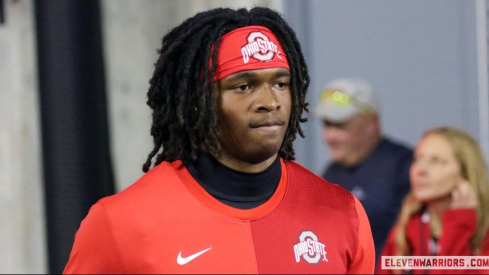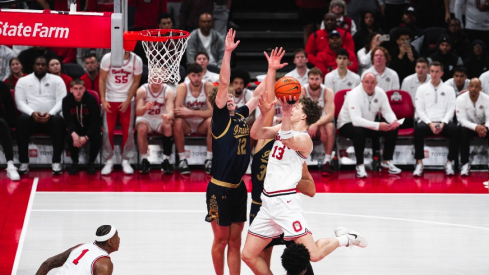 A backdrop unlike any other.
A backdrop unlike any other.What began 110 years ago as an exhibition between eastern and western football powers at Tournament Park in Pasadena, Calif., has morphed into an American institution and one of the premier annual sporting events in the world: the Rose Bowl.
Since the first game in 1902, though, the Rose Bowl Game has been a part of college football’s many changes. The first game, between Michigan and Stanford, ended after the third quarter when Stanford, trailing 49-0, quit. The game wouldn’t be played for another 15 years due to the dangers of the game. A century later, history is attempting to repeat itself. Instead of hosting a football game, the Tournament of Roses held chariot races, ostrich races and other forms of entertainment.
Appropriately the first game featured Big Ten and Pac-12 schools. Starting with the 1947 edition of “The “Granddaddy of Them All,” teams representing the Big Ten and Pac-12 would meet in 54 consecutive Rose Bowls. The close relationship between all three entities is rarely seen in today’s world of sports and business, where loyalty is non-existent. It is now one of the longest-standing associations in any walk of life.
The first non-Big Ten-Pac-12 matchup came at the hands of the Bowl Championship Series in 2002. Not only did the dreaded BCS cause angst when it came to the national championship game, it also ruined one of the grandest traditions in all of sports.
Now, with the formation of a four-team playoff, beginning with the 2014 regular season, more alterations to the Rose Bowl are on the horizon. And this time they could be death blows.
The Rose Bowl became a central focus of the discussions, as Big Ten commissioner Jim Delany and Pac-12 commissioner Larry Scott ensured the game had a voice and would not be excluded. Their anxieties were eased when the playoff stayed a part of the bowl system, but the changes could be devastating, akin to removing the smile from the Mona Lisa. The years the Rose Bowl isn’t a semifinal host guarantees Big Ten-Pac-12 matchups. However, other years are unprotected.
“I think the commissioners found a really good balance for preserving the bowl system and giving the public what they wanted,” Rose Bowl chief administrative officer Kevin Ash told Eleven Warriors. “We’re excited in regards to the future and where it might go. We know change is inevitable, and we have to adapt and move forward with college football.
 Delany has been vocal in his support of the Rose Bowl.
Delany has been vocal in his support of the Rose Bowl.“I think we did a pretty good job with the BCS. A lot of people thought we would become irrelevant in the postseason and not be as important we once were, and I think our brand today is as exciting as it’s ever been. We have two great conferences and a great game and an opportunity for some flexibility in the postseason, and I think it’s going to be a great thing.”
With six bowls taking part in the four-team playoff and a 12-year contract in place, the math tells you each bowl will host a semifinal four separate years. Simple math doesn’t apply to college athletics, though. Adam Rittenberg, of ESPN.com, reported last week that the Rose Bowl may host less frequently than the other games in an effort to keep its tri-party relationship alive.
“There are a lot of details that need worked out right now,” Ash said. “I think the commissioners are trying to work out some of the details. We really haven’t gotten to that stage yet.”
The SEC and Big XII were two of the loudest voices in the room against having a playoff played in existing bowls. Both conferences and presidents and athletics directors affiliated with them were outspoken in their criticism of the Big Ten and Pac-12’s attachment with the Rose Bowl.
“We have two great conferences,” Ash said. “I think the Pac-12 and the Big Ten produce some of the best football in this country, and I think it’s wonderful the conferences have an opportunity to play in the semifinals for the championship game. I think we’re going to have a great game here. It’s going to be a Pac-12-Big Ten game, and it’s going to be exciting. We are going to have some great games and be fine moving forward.”
 Sunset in Pasadena.
Sunset in Pasadena.Like Notre Dame, the Rose Bowl will always garner attention and not lose a shed of its relevancy. And like Notre Dame, the Rose Bowl is misunderstood among today’s youth. Teenagers don’t know the Rose Bowl like those who grew up during the game’s heyday. Sure, they’ve heard stories about the game’s importance and tradition, but the national championship game is the game that carries the most stature now.
For those who have experienced the pageantry of the Rose Bowl and watched the sunset in the Arroyo Seco, the Rose Bowl carries more meaning. Chances are if you grew up in the Midwest or on the West Coast, you dreamed of Pasadena’s Tournament of Roses. On New Year’s Day, the family was gathered around the TV in the living room, tuned into the Rose Parade and at 5 Eastern, 2 Pacific, the Rose Bowl Game kicked off. Time stood still.
“Tradition and history are very important,” Ash said. “I’ve appreciated that the older I’ve gotten. In all the talks about the BCS, because we are so close to our commissioners, we’ve been part of those discussions and even the media has been talking about change, but then they’re equally talking about the tradition and the history and how important that is.
“The Rose Bowl is part of the fabric of America. It’s who we are. It’s really important to people, and I think history is important to people. I think the semifinals and the championship game are important to evolution. But I think there is always going to be a very important role for the history and tradition of the Rose Bowl Game. I think it will always move forward and be important to people because of the longevity, the history and the tradition. People love that.”
Ohio State has been a part of that history 14 times, with the Buckeyes’ last appearance coming after the 2009 regular season. Since 1985, Ohio State has only appeared in two Rose Bowls, that number would be much higher, though, if the BCS didn’t exist. The Buckeyes have appeared in the national championship game three times during the BCS era. The most famous OSU no-show, however, came in 1962, when the faculty voted not to take part in the Rose Bowl, citing football’s popularity on campus as the reason for the snub. It caused riots and gave OSU a black eye.
 Ohio State won the 1968 national title at the Rose Bowl.
Ohio State won the 1968 national title at the Rose Bowl.Ohio State’s latest black eye has assured that they won’t be playing in the Rose Bowl this coming season – or any bowl for that matter. But Urban Meyer’s hiring and subsequent recruiting haul has reinvigorated the Ohio State fan base. The 2013 national championship is on the mind of many, and it just so happens that the Rose Bowl is hosting the title game that season.
In the final year of the BCS, the man who has mastered the system has an opportunity to turn the lights out on one of college football’s most controversial chapters with yet another signature victory. The following year the Rose Bowl may or may not be a semifinal playoff host. Regardless, change will be evident all around the game. But as things take on a new identity, so much remains the same.
“The parade will not change,” Ash said. “It will be the same lineup, with the parade segueing into the game.
“It’s a part of who we are – an American celebration.”

